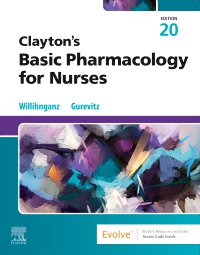Clayton’s Basic Pharmacology for Nurses - Elsevier E-Book on VitalSource, 20th Edition
by Michelle J. Willihnganz, MS, RN, CNE and Samuel L. Gurevitz, PharmD
Elsevier eBook on VitalSource
ISBN:
9780443263996
Copyright:
2026
Publication Date:
01-31-2025
Page Count:
880
Imprint:
Elsevier
List Price:
$84.99
Or $0.00 with a valid access code
Learn how to provide safe, effective nursing care for patients receiving drug therapy! Clayton’s Basic Pharmacology for Nurses, 20th Edition helps you understand the principles of pharmacology and apply them to nursing practice. This text explains how to make informed decisions about drug therapy, educate patients, and administer medications. This edition adds enhanced coverage of the NCSBN Clinical Judgment Measurement Model to prepare you for the critical thinking questions on the Next Generation NCLEX® (NGN) exam. Concise and easy to use, this essential resource helps you master the basics of medication administration and drug actions.
-
-
- NEW! Three new chapters address key topics: Drugs Used to Treat Immune and Inflammatory Disorders; Drugs Used to Treat Headaches; and Drugs Used to Treat Attention Deficit Hyperactivity Disorder
- NEW! Video and animation icons direct you to supplementary videos or animations on the companion Evolve website
- UPDATED! Accurate and current content ensures you are learning the most current drugs and treatment protocols
- EXPANDED! Additional coverage of the NCSBN Clinical Judgment Measurement Model enhances The Nursing Process and Pharmacology chapter
- Medication Safety Alerts and Clinical Pitfall boxes, as well as Do-Not-Confuse and High Alert icons highlight the importance of safe drug handling and administration
- Nursing process application provides an overview of general principles of nursing care for each disorder, as well as specific nursing considerations for the drug treatment
- Medication Administration unit clearly and visually outlines assessment, techniques, procedures, and documentation for safe administration of percutaneous, enteral, and parenteral drugs
- Drug tables clearly outline generic and brand names, availability, and dosage ranges for key medications for each disorder
- Lifespan Considerations boxes for Children and for Older Adults draw attention to information that is especially important when giving a specific drug to patients of those age groups
- Clinical Goldmine boxes focus on best practices in the clinical setting
- Extensive resources on the Evolve companion website, including math review, patient teaching guides, chapter review questions, video clips of medication administration, and animations of drug actions, help reinforce your understanding of key concepts
-
UNIT I: Introduction to Pharmacology
1. Basic Principles of Pharmacology
2. Drug Actions Across the Life Span
3. The Nursing Process and Pharmacology
4. Patient Education to Promote Health
UNIT II: Medication Administration
5. Principles of Medication Administration and Medication Safety
6. Percutaneous Administration
7. Enteral Administration
8. Parenteral Administration: Safe Preparation
9. Parenteral Administration: Intradermal, Subcutaneous, and Intramuscular
10. Parenteral Administration: Intravenous
UNIT III: Drugs Affecting Neurologic Disorders
11. Drugs Affecting the Central and Peripheral Nervous System
12. Drugs Used to Treat Neurodegenerative Disorders
13. Drugs Used to Treat Seizure Disorders
14. Drugs Used to Treat Headaches
15. Drugs Used to Treat Pain: Focus on Opioids
UNIT IV: Drugs Affecting Psychiatric Disorders
16. Drugs Used to Treat Attention Deficit Hyperactivity Disorder
17. Drugs Used to Treat Substance Use Disorders
18. Drugs Used to Treat Schizophrenia
19. Drugs Used to Treat Depressive and Bipolar Disorders
20. Drugs Used to Treat Anxiety Disorders
21. Drugs Used to Treat Sleep Disorders
UNIT V: Drugs Affecting Cardiovascular Disorders
22. Drugs Used to Treat Dyslipidemias
23. Drugs Used to Treat Hypertension
24. Drugs Used to Treat Arrhythmias
25. Drugs Used to Treat Angina Pectoris
26. Drugs Used to Treat Peripheral Vascular Disease
27. Drugs Used to Treat Thromboembolic Disorders
28. Drugs Used to Treat Heart Failure
UNIT VI: Drugs Affecting the Respiratory System
29. Drugs Used to Treat Upper Respiratory Disease
30. Drugs Used to Treat Lower Respiratory Disease
UNIT VII: Drugs Affecting the Digestive System
31. Drugs Used to Treat Gastroesophageal Reflux and Peptic Ulcer Disease
32. Drugs Used to Treat Nausea and Vomiting
33. Drugs Used to Treat Constipation and Diarrhea
UNIT VIII: Drugs Affecting the Endocrine System
34. Drugs Used to Treat Diabetes Mellitus
35. Drugs Used to Treat Thyroid Disease
UNIT IX: Drugs Affecting the Reproductive System
36. Drugs Used in Obstetrics
37. Drugs Used in Men’s and Women’s Health
UNIT X: Drugs Affecting Other Body Systems
38. Drugs Used to Treat Urinary System Disorders
39. Drugs Used to Treat Glaucoma and Other Eye Disorders
40. Drugs Used to Treat Cancer
41. Drugs Used to Treat Musculoskeletal Disorders
42. Drugs Used to Treat Immune and Inflammatory Disorders
UNIT XI: Drugs Used to Treat Infections
43. Drugs Used to Treat Bacterial Infections
44. Drugs Used to Treat Viral Infections
45. Drugs Used to Treat Fungal Infections
Appendix, Nomogram for Calculating the Body Surface Area of Adults, Children, and Infants
-
Michelle J. Willihnganz, MS, RN, CNE, RCTC Nursing Instructor, Rochester Community and Technical College, Rochester, Minnesota, USA and Samuel L. Gurevitz, PharmD, Professor Emeritus, College of Pharmacy and Health Sciences, Butler University, Indianapolis, Indiana, USA







 as described in our
as described in our 